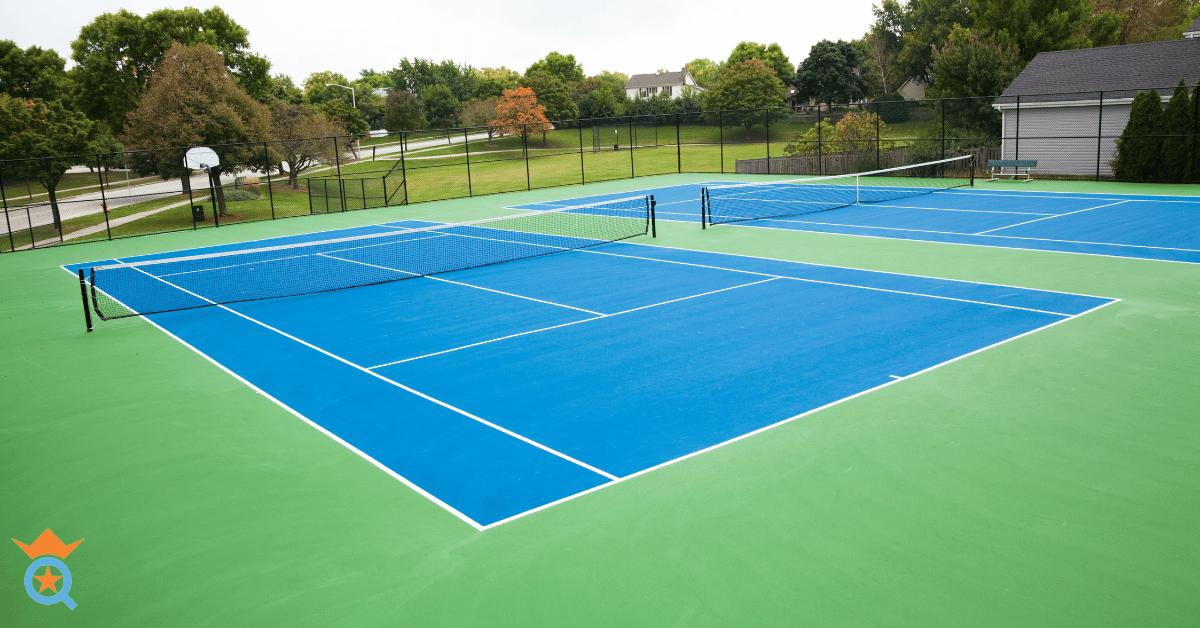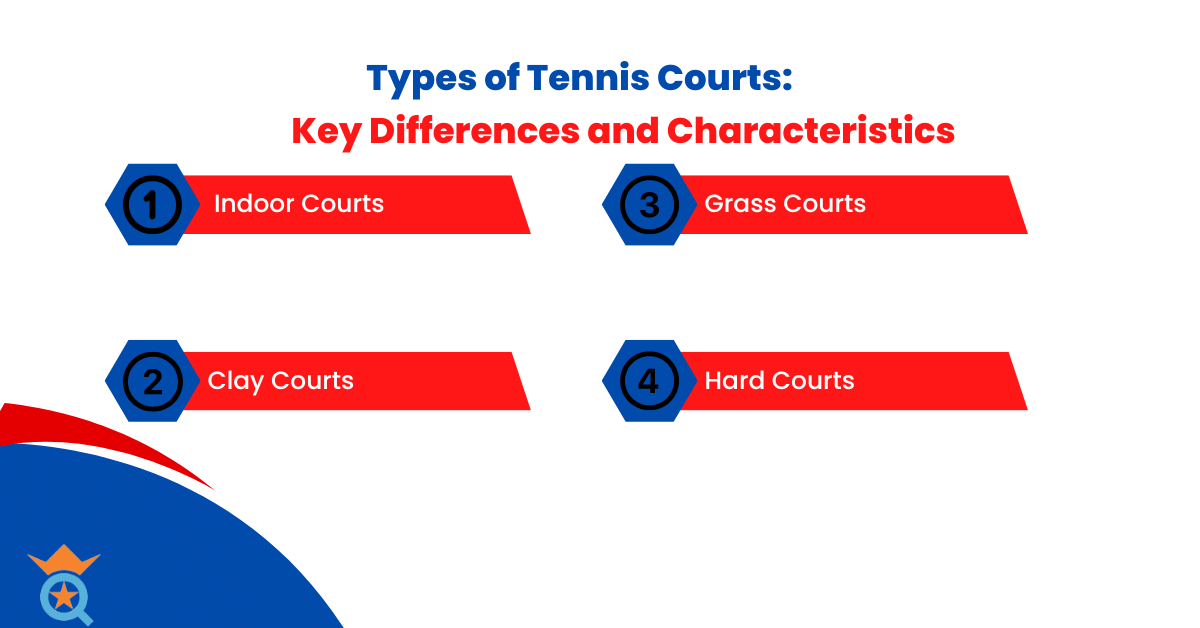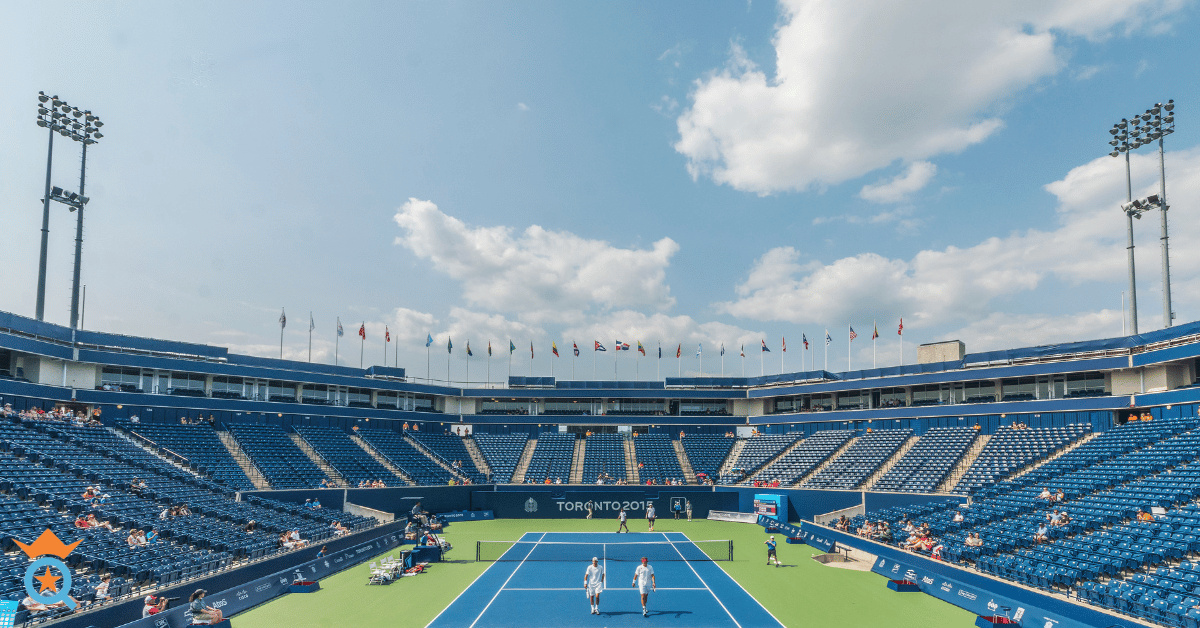Tennis, a captivating and exhilarating sport enjoyed by millions worldwide, offers a unique blend of physical prowess, strategic gameplay, and mental resilience. However, have you ever wondered how the dimensions, layouts, and surfaces of tennis courts play a crucial role in shaping the game's dynamics?
Whether you are a seasoned player, a budding enthusiast, or planning to build your own tennis court, understanding these elements is vital for optimal performance and enjoyment.
This comprehensive guide delves into the intricacies of tennis court dimensions, types, and surfaces, providing valuable insights for players of all levels. So, gear up and get ready to explore the fascinating world of tennis courts, where every detail matters!

Tennis Court Dimensions and Layout
Understanding the standard dimensions of a tennis court is essential for both players and facility builders. In this section, we will delve into the specifics of tennis court dimensions and layouts, discussing the differences between singles and doubles courts as well as the space required around a court for optimal playing conditions.
Standard Tennis Court Dimensions
A standard tennis court has a length of 78 feet (23.77 meters) and a width that varies depending on whether it is designed for singles or doubles play.
For singles matches, the court width is 27 feet (8.23 meters), while for doubles matches, the width is increased to 36 feet (10.97 meters). This results in a total playing area of 2,106 square feet (195.7 square meters) for singles courts and 2,808 square feet (260.87 square meters) for doubles courts.
Space Required Around a Court
To ensure optimal playing conditions, it is important to allocate sufficient space around the tennis court. This space, often referred to as run-off or clearance, allows players to move freely and safely during play.
The minimum distance required between the court's boundary and any surrounding obstacles (e.g., fencing, walls, or other courts) is 12 feet (3.658 meters).
However, for a more comfortable playing experience, it is recommended to increase this distance to 24 feet (7.315 meters).
Spacing Between Adjacent Courts
In facilities with multiple tennis courts, it is common to see courts built adjacent to each other. To save space or expense, these courts may not have fencing separating them. In such cases, it is crucial to maintain a minimum distance of 12 feet (3.658 meters) between the courts.
However, for optimal playing conditions and to minimize interference between games, a spacing of 24 feet (7.315 meters) between adjacent courts is recommended.
By considering these factors and adhering to the standard dimensions and layouts, players, enthusiasts, and builders can ensure a safe and enjoyable tennis experience for all.

Types of Tennis Courts: Key Differences and Characteristics
Tennis courts can be categorized into various types based on their surface material, playing conditions, and maintenance requirements. In this section, we will explore the most common types of tennis courts, including indoor courts, clay courts, grass courts, and hard courts.
1. Indoor Courts
Indoor tennis courts are designed to provide a controlled playing environment, shielded from external weather conditions. These courts can have a variety of surfaces, such as hard courts, carpet courts, or even clay courts.
The primary advantage of an indoor tennis court is its consistent playing conditions and the ability to play year-round. However, they often require higher maintenance costs due to heating, lighting, and ventilation systems.
2. Clay Courts
Clay courts are made from crushed shale, brick, or stone, providing a slower playing surface compared to other court types. The most famous clay court tournament is the French Open, held annually at Roland Garros.
Clay courts require regular maintenance, such as watering, rolling, and brushing, to keep the surface in optimal condition. The slower pace of play on clay courts often leads to longer rallies and emphasizes players' stamina, strategy, and consistency.
3. Grass Courts
Grass courts are the most traditional type of tennis court, with Wimbledon being the most prestigious grass court tournament. These courts consist of natural grass grown on hard-packed soil, which results in a faster and lower bounce compared to other surfaces.
Grass courts are known for their unpredictable playing conditions, as the ball's bounce can be affected by the grass's length, density, and moisture.
Maintenance for grass courts is extensive, involving regular mowing, watering, and reseeding to maintain a healthy and even playing surface.
4. Hard Courts
Hard courts are the most common type of tennis court, frequently used in professional, recreational, and club settings. These courts are typically made of an asphalt or concrete base, coated with an acrylic surface layer. Hard courts offer a consistent bounce and medium to fast pace of play, making them suitable for various playing styles.
Some of the most notable hard court tournaments include the US Open and the Australian Open. Maintenance for hard courts is relatively low compared to clay and grass courts, although resurfacing may be required every few years to maintain optimal playing conditions.
By understanding the characteristics and differences in playing conditions and maintenance requirements for each type of court, players can choose the surface that best suits their playing style and preferences.
Facility builders and managers can also make informed decisions when selecting and maintaining tennis courts for their venues.

Building a Tennis Court: Space Requirements and Considerations
When planning to build a tennis court, it is crucial to consider the space required for various components, such as the playing area, run-off, fencing, seating, and other amenities.
Let's discuss the necessary dimensions for international competition and recreational use of tennis courts, as well as other factors to consider during the planning process.
1. Space Requirements for Different Court Types
The dimensions of a tennis court vary depending on its intended use, with international competition courts requiring slightly larger dimensions compared to recreational or club courts. Below are the minimum court measurements for the playing area:
- International Competition: Overall Court Length: 99 ft (30.18 m)
- Overall Court Width: 48 ft (14.63 m)
- Overall Court Surface Area: 4,752 sq ft (441.48 sq m)
- Recreational or Club: Overall Court Length: 96 ft (29.26 m)
- Overall Court Width: 46 ft (14.02 m)
- Overall Court Surface Area: 4,416 sq ft (410.26 sq m)
In addition to the playing area, you should also account for space around the court for fencing or a backstop. The minimum space needed for international competition and recreational use is as follows:
- International Competition: Overall Court Length: 102 ft (30.18 m)
- Overall Court Width: 51 ft (14.63 m)
- Overall Court Surface Area: 5,202 sq ft (483.28 sq m)
- Recreational or Club: Overall Court Length: 99 ft (29.26 m)
- Overall Court Width: 49 ft (14.02 m)
- Overall Court Surface Area: 4,851 sq ft (450.67 sq m)
2. Additional Space Considerations
While the dimensions mentioned above are the minimum requirements, you may want to allocate extra space around the court to accommodate additional amenities. For example, you might want to include a covered bench, seating area, or space for ball people and umpires during matches.
Moreover, when building multiple tennis courts adjacent to each other, it's essential to maintain a minimum distance of 12 ft (3.658 m) between each court. However, for optimal playing conditions, a spacing of 24 ft (7.315 m) is recommended.
By carefully planning the space required for your tennis court, you can ensure that players have a safe and enjoyable playing experience, while also accommodating any additional amenities or features you wish to include.

Grand Slam Tournaments and Center Courts
The four Grand Slam tournaments – the Australian Open, French Open, Wimbledon, and US Open – are the most prestigious events in professional tennis. Each of these tournaments features a center court, where top-ranked players and high-profile matches take place. Let's now explore the unique features and dimensions of these center courts at each Grand Slam event.
1. Australian Open
Held annually in Melbourne, the Australian Open is played on hard courts. The center court, also known as Rod Laver Arena, boasts a retractable roof, allowing matches to continue during inclement weather.
While the playing surface dimensions remain the same as other courts at 78 ft x 36 ft (23.774 m x 10.973 m), the run-off area at Rod Laver Arena is significantly larger, providing ample space for players, umpires, ball people, and other necessary personnel.
2. French Open
The French Open, held in Paris, is unique as the only Grand Slam tournament played on clay courts. Its center court, called Court Philippe-Chatrier, was recently renovated and now features a retractable roof.
Similar to the Australian Open, the playing surface dimensions are standard, but the run-off area is more spacious, allowing for improved player movement and safety during high-stakes matches.
3. Wimbledon
Wimbledon, held in London, is the oldest and arguably the most prestigious tennis tournament in the world. It is played on grass courts, and the iconic center court, simply referred to as Centre Court, has a retractable roof as well.
The playing area dimensions are the same as other courts, but the run-off area is larger, providing players with more room to maneuver during high-profile matches.
4. US Open
The US Open, taking place in New York, is played on hard courts. Its center court, Arthur Ashe Stadium, is the largest tennis stadium globally and features a retractable roof.
As with the other Grand Slam center courts, the playing surface dimensions are standard at 78 ft x 36 ft (23.774 m x 10.973 m), but the run-off area is notably more expansive, allowing for an enhanced playing experience for competitors.
In summary, the center courts at each Grand Slam event share standard playing surface dimensions but differ in terms of run-off areas and unique features such as retractable roofs. These larger run-off spaces provide players with improved safety and maneuverability during high-stakes matches at the world's most prestigious tennis tournaments.

Tennis Court Surfaces and Maintenance
Each tennis court surface has unique characteristics that impact playing conditions, maintenance requirements, and player preferences. Let's examine the various surfaces used for tennis courts, including clay, grass, and hard courts, and discuss their maintenance needs and advantages/disadvantages.
1. Clay Courts
- Maintenance: Clay courts require regular maintenance, including daily watering, rolling, and brushing. The lines must also be frequently repainted to ensure visibility.
- Advantages: Clay courts offer a slower game with higher ball bounce, allowing for longer rallies and more strategic play. They are also more forgiving on players' joints due to their softer surface.
- Disadvantages: The maintenance requirements can be time-consuming and costly. Additionally, clay courts can be affected by weather, making them less suitable for regions with frequent rain.
2. Grass Courts
- Maintenance: Grass tennis courts demand meticulous care, including regular mowing, watering, and rolling. They also need periodic reseeding and rest periods to maintain their quality.
- Advantages: Grass courts provide a fast game with low ball bounce, which favors players with strong serves and volleying skills. The soft surface is also easier on players' joints.
- Disadvantages: High maintenance requirements and susceptibility to weather conditions make grass courts less common and more expensive to maintain. The playing characteristics can change dramatically as the grass wears down over the course of a tournament.
3. Hard Courts
- Maintenance: Hard courts are comparatively low-maintenance, requiring only occasional sweeping and resurfacing every few years to maintain optimal playing conditions.
- Advantages: Hard courts offer a consistent and medium-paced game, appealing to a wide range of playing styles. They are more weather-resistant and have lower maintenance costs compared to clay or grass courts.
- Disadvantages: Hard courts can be harder on players' joints due to their rigid surface, potentially increasing the risk of injury.
Tennis court surfaces play a significant role in the game's dynamics, with each surface offering unique advantages and challenges. When selecting a court surface, factors such as maintenance requirements, playing characteristics, and regional weather conditions should be taken into consideration.

Kids' Tennis Court Dimensions
Introducing children to tennis is made easier by adapting court sizes and equipment to suit their age and skill level. Programs such as 10 and Under Tennis (United States), Youth Tennis (United Kingdom), and Hot Shots (Australia) aim to engage kids in tennis by offering age-appropriate playing conditions.
10 and Under Tennis, Youth Tennis, and Hot Shots programs typically follow a similar format with color-coded levels that correspond to a child's age. These levels include red, orange, green, and yellow, with each stage offering different court dimensions to cater to the specific needs of the children participating.
Red Stage (8 years or younger)
- Singles Court Dimensions: 36 ft x 18 ft (10.973 m x 5.496 m)
- Doubles: Not applicable for this stage
Orange Stage
- Singles Court Dimensions: 60 ft x 21 ft (18.288 m x 6.401 m)
- Doubles Court Dimensions: 60 ft x 27 ft (18.288 m x 8.23 m)
Green Stage
- Singles Court Dimensions: 78 ft x 27 ft (23.774 m x 8.23 m)
- Doubles Court Dimensions: 78 ft x 36 ft (23.774 m x 10.973 m)
Yellow Stage
- Singles Court Dimensions: 78 ft x 27 ft (23.774 m x 8.23 m)
- Doubles Court Dimensions: 78 ft x 36 ft (23.774 m x 10.973 m)
It's essential to consider the run-off space or maintain enough distance to the sides and back of the court to ensure kids can play unobstructed. This way, children can fully enjoy the game while learning essential tennis skills.
For parents who wish to create a tennis court for their kids at home, a driveway or backyard can be transformed by chalking the tennis court lines and setting up a kids' tennis net, offering a convenient and fun way for children to learn and develop their tennis skills.
Read Next: Tennis Small Court Sensation

Popularity of the Game
Takeaways
Understanding tennis court dimensions, types, and surfaces is essential for players, builders, and enthusiasts alike. Knowledge of these aspects ensures optimal playing conditions, proper court construction, and the selection of appropriate surfaces for various levels of play.
This comprehensive guide provides detailed information on dimensions, layouts, and maintenance for professional, recreational, and kids' courts, catering to the diverse requirements of the tennis community.
Whether you are a player looking to improve your game, a builder constructing a court, or an enthusiast seeking to expand your knowledge, use this guide as a valuable reference for all your tennis-related needs.
FAQs
What is regulation tennis court material?
Regulation tennis courts predominantly feature acrylic or polyurethane surfaces, which are commonly referred to as hard courts. These surfaces are the preferred choice for courts in the United States. Hard tennis courts consist of a base layer made of concrete or asphalt, topped with a wear-resistant finishing surface composed of acrylic or polyurethane materials. These courts provide a consistent bounce and are known for their durability and low maintenance requirements.
What is the center service line?
The center service line is a crucial component of a tennis court, responsible for dividing the service area into two equal sections known as service boxes. Running perpendicular to the net, the center service line connects the service line to the net and works in conjunction with the singles' sidelines to define the boundaries of the service boxes.
How do you layout a tennis court?
To layout a tennis court, start by determining the court's dimensions based on the intended usage (singles or doubles play, recreational or professional). Ensure you have adequate space for the playing area, as well as additional space for fencing, seating areas, and other amenities. Refer to a tennis court diagram for guidance on the specific measurements and positions of the court's lines, such as the baseline, service line, center service line, and singles or doubles sidelines. It's essential to follow these specifications to create a regulation tennis court that adheres to the standard rules and requirements.








